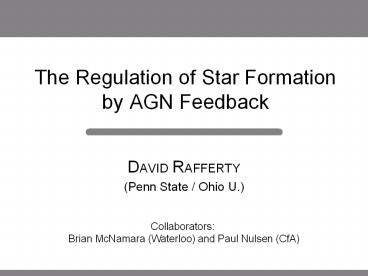The%20Regulation%20of%20Star%20Formation%20by%20AGN%20Feedback - PowerPoint PPT Presentation
Title:
The%20Regulation%20of%20Star%20Formation%20by%20AGN%20Feedback
Description:
The Regulation of Star Formation by AGN Feedback – PowerPoint PPT presentation
Number of Views:46
Avg rating:3.0/5.0
Title: The%20Regulation%20of%20Star%20Formation%20by%20AGN%20Feedback
1
The Regulation of Star Formation by AGN Feedback
- DAVID RAFFERTY
- (Penn State / Ohio U.)
Collaborators Brian McNamara (Waterloo) and
Paul Nulsen (CfA)
2
Star Formation the ICM
- Indirect evidence links the ICM to star formation
in the central galaxy. For example - Indicators of star formation correlate with
properties of the cooling flow (e.g., Heckman et
al. 1981, McNamara OConnell 1989, Cardiel et
al. 1995) - Optical line emission seen only in BCGs at the
cores of cooling flows (e.g., Edwards et al.
2007) - Cooling and star formation rates are in rough
agreement - If star formation is fueled by the cooling ICM,
there should be some relation between the
presence of SF and the central cooling
time/entropy of the ICM
3
Identifying Star Formation
- Indicators of star formation
- Optical line emission from ionized gas
- Far-IR emission from heated dust
- Excess blue/UV emission, beyond that expected
from the underlying population
A1068
A2597
McNamara et al. (2004)
Koekemoer et al. (1999)
4
Optical Data
- Sample 46 systems in the Chandra archive with a
wide range of central cooling time - U, R, and I imaging
- Search for excess blue emission in color profiles
U-I
UI images of A2390 taken at the MDM observatory
Radius (arcsec)
5
Results
The Cooling-time / Entropy Threshold
- Star formation (indicated by positive gradients)
occurs only where cooling times are short (t
7-8108 yr), whereas - Red systems have a wide range of cooling times
- This threshold may correspond to onset of thermal
instabilities in the ICM (see Voit et al. 2008,
also Soker 2008)
6
Results
CDG Location and Star Formation
- Star formation seen only in systems with small
separations between X-ray and CDG cores - However, small separations and short cooling
times are necessary, but not sufficient,
conditions - Why do some systems lack star formation?
7
AGN Feedback
- Systems with excess AGN heating
- Cooling is quenched
- Little active star formation
- Systems that are underheated
- Some cooling proceeds
- Active star formation
MS 0735.67421
Chandra X-ray (blue) B. R. McNamara VLA Radio
(red) L. Bîrzan HST Optical B. R. McNamara
8
Results
Feedback and Star Formation
- Systems in which the AGN quenches cooling
- Generally, no recent star formation
- Systems in which the AGN does not quench cooling
- Tendency for recent star formation
Net cooling Star formation
Quenched
9
Summary
- Many cooling flows have central galaxies with
active star formation - Star formation found only in systems where
- Central cooling times are short (tcool lt 5 ? 108
yr) or entropies are low (S lt 30 keV cm2) - The galaxy is very near the cluster core (?r lt 20
kpc) - The ratio of AGN heating rate to cooling
luminosity is approximately less than unity - Cooling, regulated by AGN heating, leads to star
formation in the central galaxy
10
(No Transcript)
11
Thermal Instability
- Cooling and star formation may be driven by
thermal instabilities in the hot gas - A blob of cooling gas becomes unstable to cooling
when growth rate of instabilities exceeds damping
rate from conduction
12
Radio Luminosity
- Galaxies with active star formation have larger
radio luminosities - Evidence that star formation and AGN activity
both fueled by the cooling ICM?































